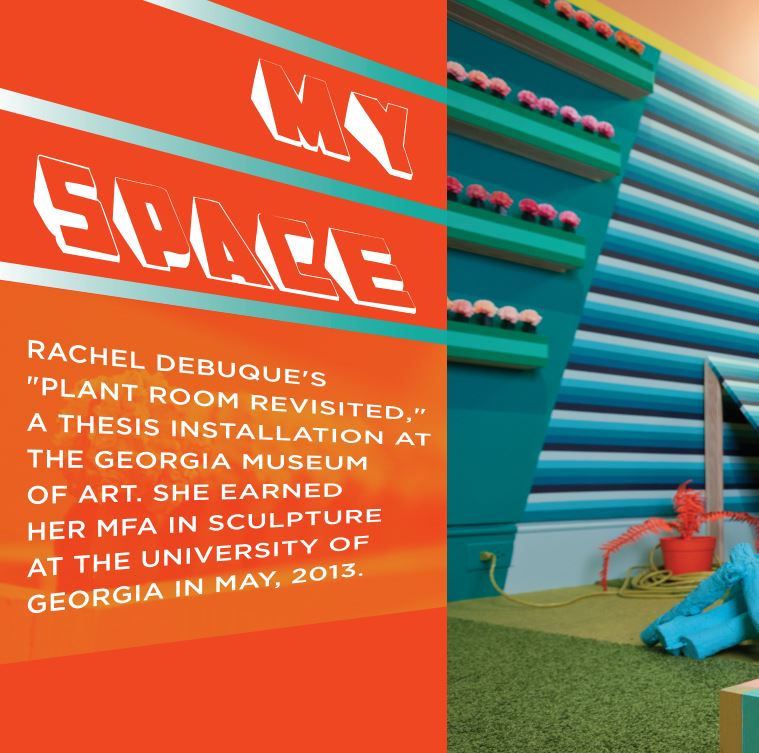My Space

By: Cynthia Adams | Photos by: Nancy Evelyn
Rachel Debuque’s “Plant Room Revisited,” a thesis installation at the Georgia Museum of Art. She earned her MFA in sculpture at the University of Georgia in May, 2013.
Early life with a nonconformist grandfather, Michael Roman, in an ever-evolving, organic home outside Philadelphia, forever altered Rachel Debuque’s ideas about living spaces and making art. When Debuque was eight years old, her family moved to a conventional home with green shag carpet and plain white walls. She says she immediately started redecorating the house, visiting yard sales and flea markets.
Her fervor to create change and manipulate space, Debuque later understood, reflected a childhood longing for the American ideal. She received a Willson Center Grant for Graduate Research to create a work titled “Cacti-Smash.” Dubuque presently teaches art courses at the New Mexico Highlands University in Las Vegas, N.M.
Your MFA installation, “Plant Room Revisited,” is a campy piece that suggests a space you might find in Domino or Elle Décor. What is really happening here?
The concept/inspiration on the surface is colorful and playful…almost like a color overload. Pop culture is certainly an inspiration. I pay attention to color and trends. We walk into a Target, or read an Elle magazine, and are media saturated. Reality becomes a blurry notion. On an ingrained level, I have always been interested in spaces.
I grew up living with my grandfather. He built his own house. It had tunnels. He made these patterns on the wall with paint and was into staging different objects. Romanesque, Athenian, and gilded things. When I got older, I thought his stuff was so tacky. Now I think, “Oh! That is completely why I am so fascinated!”
His house is continually evolving, never complete. One of the things I realize as an adult is that my grandfather is an artist, but he would never identify himself as that. His house was his continual project. He names the rooms; so, one would be called the Florida room, and has fountains, with babies spilling water into the fountain.
This is our Big Idea issue. What is the Big Idea behind your MFA piece.
I think the big idea is, what is real? What is authentic? This is the question we are constantly asking ourselves as things are so rapidly evolving we barely have time to adjust. What is real has become the slippery territory. Notions of reality is the big idea. It sometimes makes my head want to explode, but keeps me questioning things about my life.
What does the installation tell us we might not immediately note?
One of the things I started thinking about was, I get obsessed with certain furniture or objects. Two years ago I had a chair obsession—why we use them and why they look like they do. This year I became obsessed with plants. Not just any plants but house plants. We create homes to keep nature out, and then we started bringing nature in…we started bringing objects in to symbolize nature inside our homes.
The way we are about house plants reflect a lot about our culture. We like nature, but we want it neat, packaged, not messy. Look, I bring nature into my house. But for the most part, where I grew up in the Northeast, there is not a real connection to nature. You see it through a lens.
Straight out of UGA’s MFA program, you segue to Georgia O’Keefe country. Was this by design? Did you know this was your destination when you created “Plant Room Revisited?”
No, not at all. I always end up in places—most of the time, I just end up. I lived in Taiwan, Croatia, Georgia, and I never thought I would wind up there. My partner got a full-time faculty position, so we moved here. There is so much exactly like what I was talking about in the installation. Everything in Santa Fe has this regulation; it has to look a certain way, to comply with codes. So you have a giant Target that looks like adobe structure, but we know it didn’t exist 100 years ago. It’s like Disney World. There is what is really here, and what is here for the vacationers.

Rachel Debuque – MFA Sculpture. Close-up photos of Debuque’s MFA exhibit at the Georgia Museum of art. Model Sampriti De
This concept of apperception you mention in your artist’s statement—what does that mean?
Concept of apperception—I came across that term—is the notion of the simulation and the simulacra. Kant describes the recognition of an object as concrete at first, then changing. I’m interested in that, in playing with those things. The cacti on the floor of my installation were real, but on the wall were castings. The very nature of the cacti is, as a moon cactus, it wouldn’t survive more than two weeks but it was grafted onto a hardy green piece. As a mutated plant, it doesn’t exist in nature. Even if nobody knows that, I do. And I think, this is a more slippery object than I thought it was. Everything I say about space is, I want to be in between places.
Ambiguity is something we as humans have trouble with. We want to name things, for them to be neat and orderly.
And so what kind of person would own that plant room?
I played with performance throughout my career. The performance (aspect) was to complete an action, to complete the space. The people/performers took the cacti and smashed them. They looked like throwback 50s models with blonde hair and Day-Glo eye shadow. That goes back to wanting things to be nostalgic and futuristic. World War II exemplified how sameness can be this evil thing. Video games and three-dimensional things look real, but something is uncanny. Not right; just not human. We have an incredible way of recognizing it.
What is next, Rachel Debuque?
I’ve had to adjust to a lot. I don’t have a big studio. You have to make things work. Working on a smaller scale; making weird alien versions of my own cacti plants. The Southwest is an inspiration; that is certainly influencing me. I am taking a class with David Lobdell. I am doing casting. Getting to know the community.
We adjust, and interesting things come out of potential problems. I am excited, because it forces me to do that.








